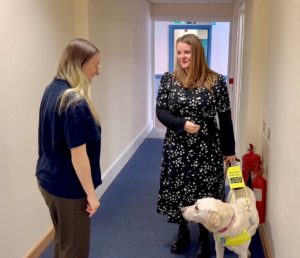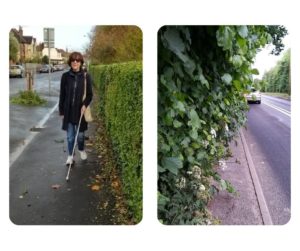See It My Way – easy things you can do to be inclusive to those with sight loss
See It My Way
Things you can do to be more inclusive
If modern life was set up in a way that was accessible for people with sight loss, then they would not be excluded or restricted. There is a lot you can do to help break down barriers blind and partially sighted people face. We have detailed some of the challenges and the simple things you can do that will make a difference to them. We can all help make the world more a inclusive place.
General challenges those with sight loss might face
- Please include me in things. As someone with sight loss, it can be hard to initiate conversation, it’s hard to pick up nonverbal cues. So one of the best things you can do is to be friendly and talk to me normally, and include me in things.
- t can feel intrusive when people ask me lots of questions about my sight loss. It’s not that I mind being asked, but if the only thing you want to know about me is what it is like living with little or no vision, I can feel a bit objectified, it’s nice when people ask me general questions about my life too.
- Please don’t feel sorry for me or talk to me in a pitying tone. I am happy and just need practical help sometimes; just like everybody else. Yes, sight loss is challenging, but pity doesn’t help me or make me feel good about myself.
- Did you know: people with sight loss don’t have to ‘look blind’. I am not training my guide dog! Even though I am looking at you and appear fully sighted, I am not and can’t see your expressions. Sight loss is different for everyone, so it’s best not to make assumptions about what people can and can’t see.
- Don’t worry about saying things like ‘look’ or ‘see’, this is normal language and I am not offended by the use of words related to vision. You don’t have to change your language when you talk to me. I ‘watch’ TV, can ‘see’ your point of view and will often ‘look’ into things. It’s fine to say ‘its nice to see you’. And, the word ‘blind’ is not offensive and should not be a taboo.
Communicating with blind and partially sighted people
- When meeting it can be very helpful if you verbally greet me – e.g. ‘Hi Anne, it’s Alison’. Otherwise, I might not know who I am talking to. It helps if you do this when you enter the room, being quiet until you are next to me can make me jump as I might not have realised you’ve entered the room.
- Please tell me if you have extended your hand to shake mine, I might not know otherwise. You could say something like ‘I would like to shake your hand’.
- If you are about to leave the room, or if someone else is leaving, Please tell me. It is difficult to know who is in the room when you can’t see. It can be frustrating and embarrassing to talk to a person who has already left the room or to an empty one.
- I am appreciative if people ask if I need help. Sometimes I do need help and sometimes I don’t. But please don’t be shy of asking or offended if I say no to your offer of assistance. There are many times I am managing fine by myself.
- If you point at something, the chances are I can’t see it. Why not just tell me what or where or who you are pointing at instead?
- Also, to point and say “it is over there” to me is not particularly useful; it is far more helpful to give me a description instead. For example, “the bus stop is about 20 feet ahead of you if you carry on in a straight line, there is a bin about half way there which you will need to walk around’ gives me much more information as I can’t see where ‘over there’ is.
- If you have a question for me, please ask me directly rather than asking whoever is with me; I can, and do, speak for myself.
- It really helps if you add image descriptions to your social media posts so anyone without sight can also enjoy your posts
If you meet someone with a guide dog – things that can help
- Please ask if you would like to say hello to my guide dog before doing so. I might have to say no if she is working. Please don’t be offended if I say no, she just needs to concentrate when she is working and must not be distracted.

- Don’t assume my guide dog never plays, she has a fantastic life and plays and receives love and cuddles as any pet would. She just also happens to have a job.
- Please don’t stop when driving to let me cross the road. I can’t see you signalling me and my guide dog can’t understand your gesture. There is a danger I will misunderstand the situation. So it’s safer if you just drive by if I am waiting at a kerb.
Challenges for visually impaired people when they are out and about
- Cars that are parked in unexpected places can be difficult for me to navigate around. If the pavement is completely blocked, I would have to get around by going onto the road which is not safe. Leaving sufficient space on the pavement for me to get by safely is also helpful to others like mothers with pushchairs and wheelchair users who won’t have to risk the traffic to get passed either.
- If you have a garden next to a pavement, please make sure that vegetation doesn’t overlap the pavement because, as well as being against the bye-laws, I often will walk into it and scratch my face. A cane only senses what is on the floor not what is at head height.

- If I am at a kerb waiting to cross the road, please ask me if I need assistance first; it can be very unnerving if someone grabs you to help without asking.
- If I need guiding, the best way is for me to take your upper arm. It helps if you warn me of upcoming obstacles or steps; including whether the steps are going up or down.
- If I am at a bus stop it can really help me if you tell me what number bus is coming, so please do ask if I would like to know.
For family and friends of those with sight loss
- It is helpful to put things back in the place they belong. I memorise where things are to find them later so they need to be where I expect them to be. If they aren’t there it will take me a long time to find them.
- If anything is left on the floor in an unusual place, I will trip over it. I will also take time to get used to a new layout of a room if the furniture is rearranged; so please tell me if something has been moved.
- It can help me if you let me know someone is talking to me. For example, in a restaurant if the waiter is asking me for my order, I might not realise. Or you can also help in a more subtle way by turning your gaze to me, so the other person knows you expect them to talk directly to me.
How you can help if you work for an organisation or business
- If you are responsible for the staff training in your organisation, consider offering vision impairment awareness training to those that are in public facing roles so they know how best to support those living with sight loss.
- If you are responsible for your organisation’s facilities, consider how you can make them as accessible as possible, e.g. good lighting and contrast, tactile marking, etc.
- If you are responsible for employing staff members, please don’t assume someone with sight loss would not be suitable, there are many adaptations that can be made to enable people to work in many different roles. The adaptions are all funded by the Government, so it doesn’t cost the organisation a penny more to employ a person with sight loss.
- If you are responsible for communications in your organisation, consider if you can offer large print and audio versions of your letters. Add descriptions to images via alt text if it is an online image or emailable document and always add image descriptions to social media posts. There is a lot you can do to make communications accessible.
- If you are working with someone living with sight loss do ask if they would like to see any papers or presentations in advance.
- When using Zoom or other digital platforms, do say your name before you speak and always respond verbally to a question – nods of the head or thumbs up can be difficult to see.
